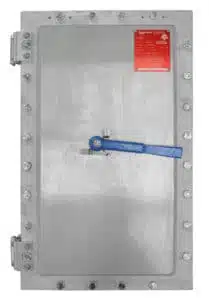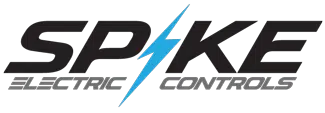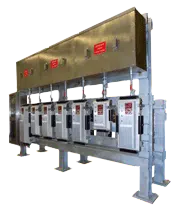
In hazardous areas where flammable gases, vapors, and combustible dusts are present, electrical equipment must meet stringent safety standards to prevent explosions. One crucial component in these environments is the explosion-proof disconnect, a specialized switch assembly that ensures the safe disconnection of electrical circuits. In this blog, we will delve into the concept of explosion-proof disconnects, explore their technical features, and focus on Spike Electric Controls’ offering, the Eaton Crouse-Hinds Hazardous Location Enclosures.
I. Understanding Explosion-Proof Disconnects:
Explosion-proof disconnects are electrical switch assemblies designed to contain and prevent sparks, arcs, or heat generated within the enclosure from igniting the surrounding flammable atmosphere. These disconnects play a vital role in hazardous areas such as oil refineries, chemical plants, and manufacturing facilities where the potential for explosions exists.
Technical Overview
1. Construction and Features:
The explosion-proof disconnects from Spike Electric Controls utilize Eaton Crouse-Hinds Enclosures’ high integrity manufacturing standards to ensure reliability and safety. These disconnects are housed in compact NEMA 4/7 enclosures, which provide a space-efficient solution for hazardous environments.
Some key features include:
a. Field Installation Capability: The internal disconnects can be replaced in the field, allowing the switch to be installed in the field while maintaining product certification.
b. Moisture Control: A NEMA 4X breather and drain** are incorporated to address moisture- related concerns in hose-down applications, ensuring the longevity of the disconnects.
c. Compact Design: The disconnects have a small footprint, requiring less mounting space while still delivering robust performance.
d. Rotary Handle Operator: A large red painted aluminum rotary handle operator mounted on the cover assembly enables reliable operation and easy identification of the switch position from a distance.
e. Environmental Protection: The disconnects feature a neoprene cover gasket, providing a NEMA 4 (hosetight) environmental rating to safeguard against the ingress of water and dust.
f. Mounting Flexibility: Detachable and adjustable mounting feet offer various installation options and simplify maintenance by providing easy internal access for wiring and upkeep.
g. Conduit Entries: Standard top and bottom conduit entries (1/2" NPT) facilitate the feeding of conductors and allow for the addition of breathers, drains, or auxiliary contacts in the field.
h. Lockout/Tagout Capability: The disconnects comply with OSHA requirements for lockout/tagout procedures, enabling safe maintenance by allowing the switch to be locked in the ON or OFF position.
2. Certifications and Compliances:
The Spike Electric Controls’ explosion-proof disconnects meet various certifications and
compliances, ensuring their suitability for hazardous environments. These include:
a. NEC/CEC: The disconnects comply with the National Electrical Code (NEC) and the Canadian Electrical Code (CEC).
b. Hazardous Location Ratings: They are suitable for Class I, Division 1 and 2 (Groups B, C, D), Class II, Division 1 and 2 (Groups E, F, G), and Class III hazardous areas.
c. NEMA Ratings: The disconnects meet the requirements of NEMA 3, 3R, 4 or 4X* (depending on the model), 7BCD, 9EFG.
d. UL and CSA Standards: They conform to UL Standard 1203 and are cUL listed to CSA C22.2 No. 30.
II. Exploring Non-Fused and Fused Disconnects:
1. Non-Fused Disconnects:
Non-fused disconnects are designed for applications where circuit protection is provided by other means, such as upstream fuses or circuit breakers. These disconnects act solely as a switch, providing a means of safely disconnecting the electrical circuit from the power source. They are commonly used in situations where frequent maintenance or troubleshooting requires frequent power interruption without affecting circuit protection.
2. Fused Disconnects:
Fused disconnects, on the other hand, integrate fuses within the switch assembly. This design provides both the function of a switch and circuit protection in a single unit. Fused disconnects offer the advantage of localized overcurrent protection, allowing for quick identification and replacement of blown fuses without interrupting power to the entire circuit.
III. Ratings, Gas Groups, and Degrees of Protection:
1. Ratings:
Explosion-proof disconnects are assigned various ratings based on their ability to withstand different hazardous conditions. These ratings include:
a. Class I, Division 1 and 2: Suitable for areas where flammable gases, vapors, or liquids are present during normal operation.
b. Class II, Division 1 and 2: Designed for environments containing combustible dust.
c. Class III: Specifically for locations where easily ignitable fibers or flying particles are present.
2. Gas Groups:
Explosive gases are categorized into different groups based on their properties. The most common gas groups associated with explosion-proof disconnects are:
a. Group B: Hydrogen and gases of equivalent hazard.
b. Group C: Ethylene and gases of equivalent hazard.
c. Group D: Propane and gases of equivalent hazard.
3. Degrees of Protection:
Explosion-proof disconnects provide varying degrees of protection against ingress of solid objects and water. These degrees are classified using the IP (Ingress Protection) code. Some common IP ratings for explosion-proof disconnects are:
a. IP66: Protects against dust and powerful jets of water.
b. IP67: Protects against dust and temporary immersion in water.
c. IP68: Protects against dust and continuous immersion in water under specified conditions.
Conclusion:
Explosion-proof disconnects are indispensable components in hazardous areas, ensuring the safe operation and maintenance of electrical systems. Spike Electric Controls, in collaboration with Eaton Crouse-Hinds, offers a range of high-quality explosion-proof fused and non-fused disconnects. By adhering to strict manufacturing standards and meeting relevant certifications, these disconnects provide reliable performance, compact design, and crucial safety features.
Whether it’s for Class I, Division 1 and 2, Class II, Division 1 and 2, or Class III hazardous locations, the explosion-proof disconnects from Spike Electric Controls offer peace of mind and compliance with industry regulations.
How does the Nema 7 Disconnect Enclosure work?
1. In hazardous locations, NEMA 7 enclosures are specifically designed to confine and control explosions that may occur from within. These enclosures are built to meet the requirements of hazardous environments where flammable gases or vapors are present. Their purpose is to prevent the ignition of the surrounding hazardous atmosphere by limiting potential ignition sources within the enclosure.
2. It’s important to note that NEMA 7 enclosures are not gas-proof: If gas manages to enter the enclosure and an internal spark ignites it, the explosion and flames will be contained within the enclosure itself. This prevents the ignition from spreading to the gas present outside the enclosure, thereby averting a catastrophic event that could cause extensive damage and harm to people in the vicinity.
3. In such cases, the explosion will be limited to the enclosure, resulting in a localized event. Although the disconnect within the enclosure may need to be replaced, the cost of this replacement is relatively small compared to the potential damage that could occur if the gas were to ignite throughout the entire facility.
4. By utilizing NEMA 7 enclosures, the goal is to confine and control explosions, ensuring the safety of the surrounding environment and minimizing the risks associated with flammable gases or vapors.
5. Robust Construction:
Materials: NEMA 7 enclosures are typically constructed using heavy-duty materials such as cast iron or aluminum with high mechanical strength. These materials are selected for their ability to withstand the forces
generated during an explosion.
Sealing: The enclosures are equipped with robust sealing mechanisms, including gaskets and O-rings, to prevent the escape of gases or sparks.
6. Flame Path:
Flame Arresters: NEMA 7 enclosures often include flame arresters, which are specially designed devices that allow the flow of gases while preventing the propagation of flames. Flame arresters consist of a series of small passages or mesh screens that disrupt the flame front, extinguishing it before it can exit the enclosure.
Restricted Openings: NEMA 7 enclosures have restricted openings to control the release of flames or ignited gases. These openings are designed to limit the size and velocity of any expelled gases, reducing the potential for secondary explosions.
7. Pressure Relief:
Pressure Relief Mechanisms: Hazardous location enclosures, including NEMA 7 enclosures, are equipped with pressure relief mechanisms. These mechanisms allow controlled release of pressure in the event of an internal explosion, preventing excessive build-up and subsequent rupture of the enclosure. Common pressure relief mechanisms include pressure relief vents or panels that are designed to open and release the pressure while minimizing the release of flames or ignited gases.
8. Internal Volume:
Containing Internal Explosion Forces: The internal volume of the NEMA 7 enclosure is carefully designed to contain the forces generated during an internal explosion. The enclosure is engineered to withstand these forces without rupturing or compromising its structural integrity.
It is important to note that NEMA 7 enclosures are specifically designed for specific hazardous location classifications, such as Class I, Division 1 or Division 2, and are intended to be used in conjunction with other safety measures and proper installation practices to ensure maximum protection.
In summary, a hazardous location NEMA 7 enclosure contains an explosion through its robust construction, flame arresters, restricted openings, pressure relief mechanisms, and careful design to withstand internal explosion forces. These features work together to confine and control the explosion, preventing the ignition of the surrounding hazardous atmosphere and minimizing the risk of secondary explosions.
Written by: Cole Attaway
Cole Attaway is the founder and CEO of Spike Electric Controls. Spike’s mission is to improve the accessibility and delivery of industrial electrical gear for clients nationwide. Spike solutions result in reduced unplanned downtime, less overtime, and greater operational efficiencies.


